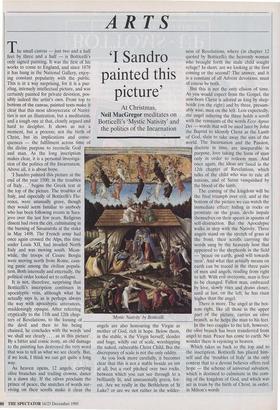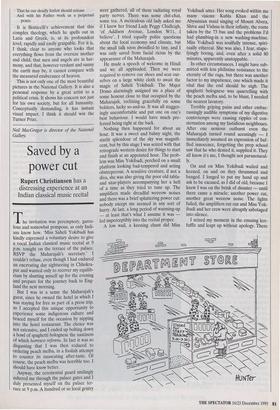ARTS
`I Sandro painted this picture'
At Christmas, Neil MacGregor meditates on Botticelli's 'Mystic Nativity' and the politics of the Incarnation The small canvas — just two and a half feet by three and a half — is Botticelli's only signed painting. It was the first of his works to come to England, and since 1878 it has hung in the National Gallery, enjoy- ing constant popularity with the public. This is in a way surprising, for it is a puz- zling, intensely intellectual picture, and was certainly painted for private devotion, pos- sibly indeed the artist's own. From top to bottom of the canvas, painted texts make it clear that this most idiosyncratic of Nativi- ties is not an illustration, but a meditation, and a tough one at that, closely argued and hard to decipher. It shows us not a moment, but a process; not the birth of Christ, but its implications and conse quences — the fulfilment across time of the divine purpose to reconcile God and man. As the long inscription makes clear, it is a personal investiga- tion of the politics of the Incarnation. Above all, it is about hope.
'I Sandro painted this picture at the end of the year 1500, in the troubles of Italy . ..' begins the Greek text at the top of the picture. The troubles of Italy, and especially of Botticelli's Flo- rence, were unusually grave, though they would seem familiar to anybody who has been following events in Sara- jevo over the last few years. Religious dissent had riven the city, culminating in the burning of Savanarola at the stake in May 1498. The French army had once again crossed the Alps, this time under Louis XII, had invaded North Italy and was moving south. Mean- while, the troops of Cesare Borgia were moving north from Rome, caus- ing panic among the civilian popula- tion. Both internally and externally, the political order looked set to collapse.
It is not, therefore, surprising that Botticelli's inscription continues in apocalyptic vein, although what he actually says is, as is perhaps always the way with apocalyptic utterances, maddeningly opaque. After referring cryptically to the 11th and 12th chap- ters of Revelations, to the loosing of the devil and then to his being chained, he concludes with the words 'and we shall see clearly .... as in this picture'. By a bitter and comic irony, an old damage to the painting has destroyed the very word that was to tell us what we see clearly. But, if we look, I think we can get quite a long way.
As heaven opens, 12 angels, carrying olive branches and trailing crowns, dance in a dawn sky. If the olives proclaim the prince of peace, the snatches of words sur- viving on their scrolls make it clear the Mystic Nativity' by Botticelli angels are also honouring the Virgin as mother of God, rich in hope. Below them, in the stable, is the Virgin herself, slender and huge, wildly out of scale, worshipping the naked, vulnerable Christ Child. But the discrepancy of scale is not the only oddity.
As you look more carefully, it becomes clear that this is not a stable beside an inn at all, but a roof pitched over two rocks, between which you can see through to a brilliantly lit, and unseasonally green, for- est. Are we really in the Bethlehem of St Luke? or are we not rather in the wilder- ness of Revelations, where (in chapter 12 quoted by Botticelli) the heavenly woman who brought forth the male child sought refuge? In short, are we looking at the first coming or the second? The answer, and it is a constant of all Advent devotions, must of course be both.
But this is not the only elision of time. As you would expect from the Gospel, the new-born Christ is adored as king by shep- herds (on the right) and by three, presum- ably wise, men on the left. Less expectedly, the angel ushering the three holds a scroll with the remnants of the words Ecce Agnus Dei — words that will be used later by John the Baptist to identify Christ as the Lamb of God, slain to take away the sins of the world. The Incarnation and the Passion, discrete in time, are inseparable in purpose, love taking the form of man only in order to redeem man. And once again, the ideas are fused in the 12th chapter of Revelations, which talks of the child who was to rule all nations, and of Satan vanquished by the blood of the lamb.
The coming of the kingdom will be the final triumph over evil, and at the bottom of the picture we can watch the immediate effect: hiding in rocks or prostrate on the grass, devils impale themselves on their spears in spasms of self-destruction. But the Apocalypse walks in step with the Nativity. Three angels stand on the stretch of grass at the front, their scrolls carrying the words sung by the heavenly host that appeared to the shepherds in the field — 'peace on earth, good will towards men'. And what that actually means on earth can be traced in the three pairs of men and angels, reading from right to left. With evil overcome, man is free to be changed. Fallen man, embraced by love, slowly rises and draws closer, until at last, on the left, he has risen higher than the angel.
There is more. The angel at the bot- tom right, like all those in the upper part of the picture, carries an olive branch, as he helps the man to his feet. In the two couples to the left, however, the olive branch has been transferred from angel to man. Peace has come to earth. No wonder there is rejoicing in heaven.
Which takes us back to the top and to the inscription. Botticelli has placed him- self and the 'troubles of Italy' in the only context that to a devout believer offers real hope — the scheme of universal salvation, which is destined to culminate in the com- ing of the kingdom of God, and which was set in train by the birth of Christ, in order, in Milton's words That he our deadly forfeit should release And with his Father work us a perpetual peace.
It is Botticelli's achievement that this complex theology, which he spells out in Latin and Greek, is, at its profoundest level, rapidly and easily graspable. For it is, I think, clear to anyone who looks that everything flows from the oversize mother and child, that men and angels are in har- mony, and that, however verdant and sunny the earth may be, it cannot compare with the measured exuberance of heaven.
This is not only one of the most beautiful pictures in the National Gallery. It is also a personal response by a great artist to a political crisis. It shows his concern not just for his own society, but for all humanity. Conceptually demanding, it has instant visual impact. I think it should win the Turner Prize.
Neil MacGregor is director of the National Gallery.











































































































 Previous page
Previous page